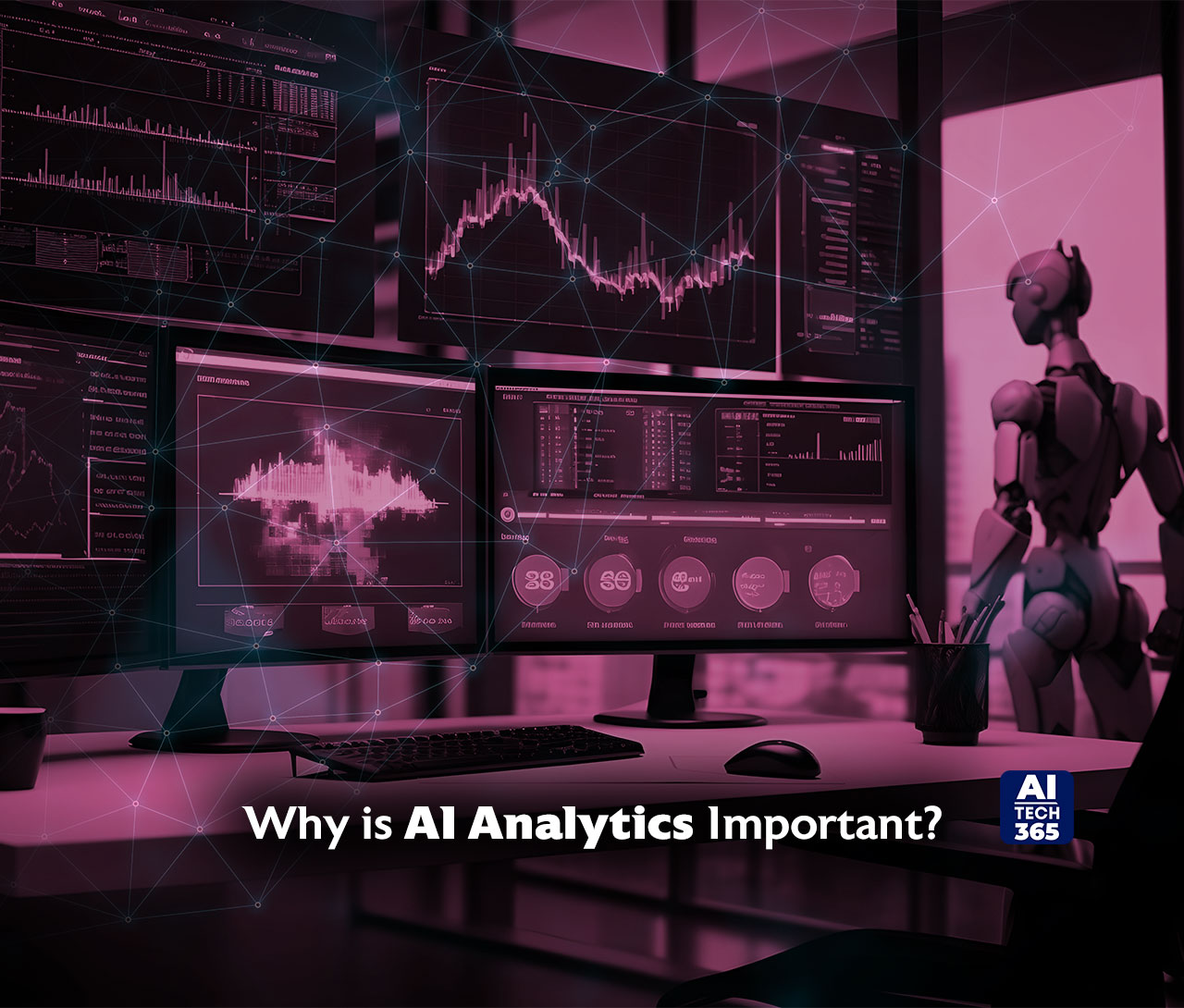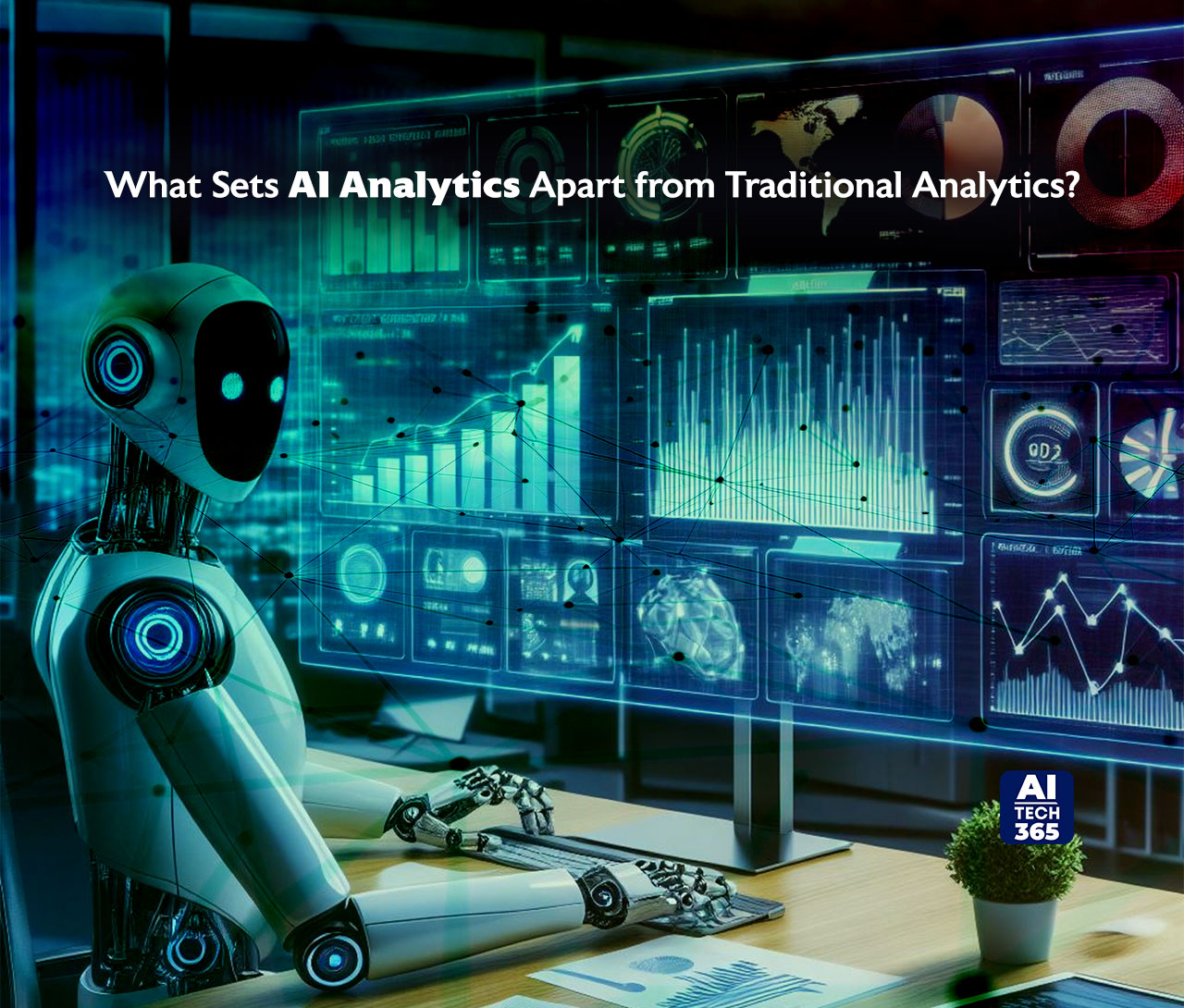What if there’s a way to understand customer behaviors without manually extracting and understanding data? What if there’s an artificial intelligence tool that gives you details on not only what happened but why it happened and what’s most likely to happen?
If your answer is a big YES, then AI analytics is the one for you (not the soulmate one).
With the AI market projected to reach $826.70 billion by 2030, companies are increasingly adopting AI to streamline processes, including data analytics. This article is a nutshell of everything you need to know about this topic.
What is AI Analytics?
AI analytics is a field that merges artificial intelligence (AI) and machine learning with traditional analytics. This combination helps generate insights, automate processes, make predictions, and drive actions that lead to better business outcomes.
By using machine learning, artificial intelligence analytics can process large volumes of data to identify patterns, trends, and relationships without requiring human input. This empowers businesses to make data-driven decisions and stay competitive.
Additionally, it can handle both structured and unstructured data—such as text, images, and videos—using advanced tools like natural language processing, speech analytics, and computer vision.
Why is AI Analytics Important?
AI analytics is important because it allows organizations to gain valuable insights, make data-driven decisions, improve efficiency and performance, enhance the customer experience, and gain a competitive advantage. By analyzing large amounts of data and identifying patterns, artificial intelligence analytics provides deeper understanding of operations, customers, and the market.
It automates tasks, freeing up time for higher-value activities, and enables personalized recommendations and optimized marketing campaigns. With the ability to uncover hidden insights and predict future outcomes, organizations can adapt strategies and stay ahead in the market.
What Sets AI Analytics Apart from Traditional Analytics?
To understand the transformative impact of artificial intelligence analytics, let’s explore how it differs from traditional data analytics.
Traditional Analytics Approach
In a conventional setup, a team of data analysts typically handles the analytical tasks. Here’s how they might address a business challenge, such as a decline in quarterly sales:
- Identify the Issue: Analysts notice a trend, such as a drop in sales over the quarter.
- Formulate Hypotheses: They develop potential explanations for the sales decrease.
- Test Hypotheses: The analysts test these hypotheses against the relevant data to find evidence supporting one or more of their theories.
- Report Findings: They compile a report summarizing their findings and suggest possible actions for the business to take.
This process is not only time-consuming but also prone to limitations. The accuracy of the results depends on the analysts’ assumptions and their ability to interpret the data correctly.
AI Analytics Advantage
AI analytics revolutionizes this process with machine learning algorithms that continuously monitor and analyze vast amounts of data. Here’s how artificial intelligence analytics outperforms traditional methods:
Scale
AI data analytics can process data at any granularity without needing explicit instructions on what to look for. It can handle revenues by country, product, channel, and more, making it vastly more scalable than traditional methods.
Speed
AI models detect unusual changes in data, such as a sudden drop in revenue, and alert relevant teams in real-time. This immediate response is possible because AI data analytics uses clustering and correlation algorithms to provide root-cause analysis swiftly. Traditional analytics, in contrast, often operates on a quarterly, monthly, or weekly basis at best, delaying issue identification and resolution. For instance, according to Anodot’s 2023 Cloud Cost Report, 84% of their clients detect anomalies within hours, far surpassing the market average.
Accuracy
Machine learning algorithms in artificial intelligence analytics learn various patterns of normal behavior with high precision and can correlate anomalies across millions of data points. This level of accuracy is nearly impossible for human analysts. Moreover, these algorithms operate without the biases that human analysts might have, allowing for a more objective analysis. Automated data analysis can test countless hypotheses quickly, providing insights in seconds rather than weeks.
What Are the Applications Of AI Analytics?
Here are some key examples:
- Image and Speech Recognition: Deep learning algorithms in AI data analytics power image and speech recognition technologies. These are used in self-driving cars, voice assistants, and other AI-driven systems, enabling them to interpret visual and auditory information accurately.
- Data-Driven Decision Making: It empowers organizations with data-driven decision-making capabilities. By providing natural language search, predictive insights, and generative AI that explains findings as they emerge, companies can better understand, measure, and act on their business data.
- Forecasting and Predictive Analytics: It can forecast product demand by analyzing historical data, seasonal trends, and past purchase behaviors. This helps businesses optimize inventory management, supply chain networks, and maintenance schedules, ensuring they meet customer demand efficiently.
- Customer Behavior Analysis: Organizations use artificial intelligence analytics to gain deep insights into customer behavior and preferences. This allows them to personalize recommendations, optimize marketing campaigns, and enhance the overall customer experience, leading to increased customer satisfaction and loyalty.
- Fraud Detection and Security: It is crucial in detecting and preventing fraud. It helps insurance companies and other organizations analyze large datasets to identify suspicious patterns and anomalies, ensuring data integrity and enhancing security measures.
- Process Optimization: It optimizes various business processes by identifying inefficiencies and suggesting improvements. This helps organizations streamline operations, reduce costs, and boost productivity, leading to better overall performance.
Challenges Of Using AI Analytics
Implementing artificial intelligence analytics offers significant benefits, but it also comes with several challenges that organizations need to address:
- Ethical and Regulatory Concerns: AI-driven data analytics can raise complex ethical and regulatory issues, especially when analyzing sensitive data like personal or medical information. Organizations must ensure compliance with data protection regulations, such as GDPR and HIPAA, to address privacy, security, and consent concerns.=
- Interpretability and Explainability: It often relies on complex machine learning algorithms that can be difficult to interpret and explain. Ensuring transparency and understanding how these AI systems arrive at their conclusions can be a significant challenge.
- Talent and Expertise: Successfully implementing AI driven analytics requires professionals skilled in both AI and analytics. However, there is a scarcity of talent in this field, which can prevent organizations from fully leveraging the potential of AI-driven analytics.
- Data Management and Integration: Artificial intelligence analytics depends on integrating data from various sources while maintaining data quality. This involves challenges such as data cleaning, data governance, and providing self-service access to data. Many organizations struggle with managing the entire data value chain due to a lack of the necessary talent and expertise.
- Bias and Fairness: It can inadvertently perpetuate biases present in the training data, leading to unfair outcomes. Ensuring fairness and avoiding discrimination in AI-driven decision-making processes is a critical challenge that organizations need to address.
- Data Relevance and Reliability: Ensuring the data used in artificial intelligence analytics is relevant and reliable is crucial. Organizations need robust data collection processes and must be vigilant about potential biases and limitations in the data.
- User Acceptance and Interface Design: For artificial intelligence analytics to be effective, the interfaces must be user-friendly, and the functionality of AI solutions must be continuously monitored. Ensuring that users feel comfortable and supported when interacting with AI systems is essential for user acceptance.
Will AI Take Over Data Analytics?
Most fear their jobs are at risk due to the integration of AI, but the truth is AI will not take over data analytics. This is because AI analytics is a new concept.
Fear of AI can hinder its adoption as employees may resist and deprioritize automation, viewing it as a threat to their roles. Additionally, some worry that autonomous analytics lacks the creativity and nuanced understanding of human researchers.
However, artificial intelligence analytics offers significant benefits. It automates tedious and unfulfilling tasks, freeing employees to focus on more strategic and rewarding activities. This not only enhances job satisfaction but also boosts organizational efficiency and growth.
Artificial intelligence can help with:
- Eliminating routine reports
- Enabling fast, relevant, and important answers
- Leads to active data discovery
- Fosters agility and creativity
Key Takeaway
AI analytics is revolutionizing the way we extract insights from vast datasets, fundamentally transforming data teams and businesses. It presents a once-in-a-generation opportunity by bridging the gap between human intuition and machine precision. With artificial intelligence, users receive valuable insights proactively, often before they even know the questions to ask. This technology empowers users to explore data without limits, satisfying their curiosity and uncovering deeper insights that drive strategic decision-making.


